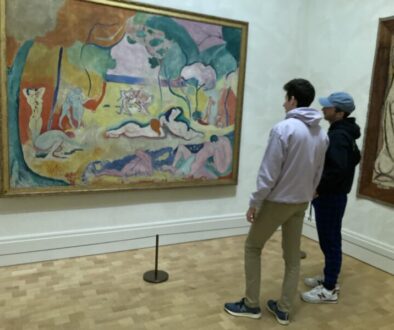The Cresse-Holmes House: If These Walls Could Talk

A trove of local history sits along the eastern face of Route 9 in Cape May Court House. Many have driven past, but surprisingly few have ventured inside—at least, that is the constant refrain from those who finally do stop by the Museum of Cape May County: “I’ve lived in the area my whole life and have never been in here!” Those who grew up here are all too familiar with this predicament. Rarely are we able to enjoy the amenities of our increasingly popular destination hometown.
Whether you are a local, or just visiting, the Museum of Cape May County is worth the stop. There is something there for virtually every interest. Like military history? We’ve got you covered. Want to see a historic doctor’s sulky? Check. Glass bottles or Victorian pharmaceuticals? Check. Decorative arrangements made completely of human hair? Yep. Creepy dolls (we’re not judging, promise)—look no further. Aside from the broadest representation of historic life and the oldest cultural materials in the county, the Museum is also home to the largest collection of local genealogical data (and yes, we can help you trace your family’s lineage).
The Cape May County Historical & Genealogical Society, which owns and operates the Museum, has been dedicated to preserving local history since 1927. That’s right, the Society has been saving old (but important) things for nearly 100 years. At this point, even the first accession records kept by the Society are now themselves historic documents. The Cresse-Holmes House, serving as the Society’s tourable historic house museum, happens to be one of the most significant components of the Society’s preservation efforts.

Here is a quick review of the Cresse-Holmes House owners: John Cresse (1671–1729) inherited the property from his father, Arthur (1650–1714), and likely built the two-story home that is the rear section of the Cresse-Holmes House in 1704. He then willed it to his son Robert (1690–1768) in 1729, who willed it to his son Jonathan (1733?–1795?) in 1768, who sold it to John Holmes (1746–1791) in 1777. John Holmes apparently did not live in the Cresse-built home that sat on his new property, but instead built a house on the opposite side of the road. John’s son Robert Morris Holmes (1782–1840) inherited the property (and both homes) when John died in 1791. Robert suffered from rheumatism and felt his father’s home was too damp for his health, so he tore it down and built what is now the main block of the Cresse-Holmes House in 1830. How the Cresse section of the house was used while the Holmes family lived on the other side of the road is still under investigation—a slave quarters, perhaps, since both John and Robert Holmes were slave owners).
When Robert died intestate (without a will) in 1840, the Orphan’s Court gave the property to his son Richard Collins Holmes (1813–1863). Richard died in 1863, also intestate, and his children (Joseph, Harry, Richard Jr., Mary, Charles, and Emma) received equal shares of the property. By the time his daughter Emma passed in 1934, property shares were held only by her and her niece Anna Ebelhare (only child of Richard Jr.). Emma willed her estate to her two nieces, Anna Ebelhare and Nellie Leaming (daughter of Mary). Nellie and Anna sold the property to Palmer and Sara Way in 1935, marking the end of Holmes family ownership. The Ways sold the property to Ulric and Christine Laquer in 1957, who then sold the property to the Cape May County Historical and Genealogical Society in 1976.
The Cresse-Holmes house is a must-see for a variety of reasons. Part of this house has been standing longer than The United States of America has existed. Architecturally, it is a well-preserved example of both the first period (ca. 1690–ca. 1730) and third period (ca. 1780/90–ca. 1830) heavy timber frame construction. Both periods are represented by a variety of original features, from exposed, decorated hand-hewn framing members in the first period Cresse section to the modestly exposed timber framing and remarkably crafted front door, mantels, trim, and staircase in the third period Holmes section.

There is an interesting (and purely coincidental) connection between the 1830 Holmes construction and what is regarded by many as the Society’s most famous historic artifact: the original First Order Fresnel Lens from the Cape May Lighthouse. Robert Morris Holmes likely hired father and son duo Reuban and Downes Foster from Lower Township to build his 1830 home. The Fosters appear to be the master carpenters responsible for the extraordinary, nearly identical work found in almost a dozen extant 19th century homes in the county. The mantels, trim, staircase, and front door of the Cresse-Holmes House are all particularly fine examples of their skills. Downes Foster was also keeper of the Cape May Lighthouse from 1850 to 1878 and was responsible for handling and maintaining the very same lens that currently sits on display in the Museum barn.
Perhaps most intriguing of all are the items within the Cresse-Holmes House that embody the personal experiences of those who lived and labored on the property. Fortunately, we are privy to the details of some of the intriguing stories that are preserved within these walls.
Take the story of the Hessian gun that rests upon the fireplace mantle in the Colonial Kitchen, for example. The John Holmes who purchased the property from Jonathan Cresse in 1777 had a nephew named (confusingly enough) John Holmes. This John was the son of Nathaniel Holmes, who lived just a mile south on the same road. In 1811, newlywed John the younger was hunting with his brother at Cedar Hammocks in Upper Township when, according to numerous records, the gun accidentally discharged, killing him.

His brother was apparently so distraught by this that he promptly gave the gun away, behavior for which there are undoubtedly any number of not-suspicious explanations. The obituary of John’s wife (Hannah Hand) many years later mentions that her late husband died of a self-inflicted gunshot wound. In 1930, the gun that killed young John Holmes was donated to the Museum so that it could rest among familial belongings—the mantel it is hung on even came out of the circa 1700 section of his father Nathaniel’s home. This gun is nearly five feet long, and it is difficult to imagine how anyone could possibly shoot themselves with it, accidentally or not. So, what really happened between the brothers that day in the marsh?
One of the more prominent residents of the Cresse-Holmes House was Richard C. Holmes, whose innovative take on lifeboats saved an estimated thousands of lives. A series of his personal letters are quietly preserved in the Museum vault. His mother, Mary Leaming Holmes, his sister, Charlotte Holmes Townsend and his brother-in-law, prominent yet problematic naturalist John K. Townsend, wrote to Richard C. often, revealing a deeply affectionate family entirely as concerned with one another’s affairs as we are today. Somehow, it’s comforting to know that historical figures were curious about all the family gossip too.
From troubling descriptions of various familial ailments to cheerful chatter about visiting friends, these letters span the full range of human experience and emotion. Richard was kept up to date with everything of note that happened in his family, from the powerful devotion of his brother-in-law John towards his sister Charlotte to the devastating stillbirths and childbirth-related illnesses of sister Harriet Holmes Baird as well as subsequent happy news of children born healthy.


Richard’s mother was particularly inclined to share more trivial but interesting news. In one letter she wrote about Charlotte’s husband John while he was working as a dentist in Philadelphia (Mary was living with them at the time). Mary recounts a story about John’s use of the newly introduced inhalant anesthetic chloroform on one of his patients: “He took a tooth out for a boy today who was so unconscious of the operation, he told John he might take it out if he wants to, as he was ready, when the tooth was lying on the table. John showed it to him, when he uttered a rough exclamation of surprise.”
These nearly 200-year-old family stories are embodied in other materials at the Museum as well. Hanging in the parlor is an exquisite 1855 portrait of Mary Leaming Holmes painted by none other than her own daughter, Charlotte. Charlotte was an especially gifted artist, and the Museum has at least three other fine examples of her work: a portrait of her nephew Joseph Hand Holmes, son of Richard C. Holmes and his wife Emma Hand; a portrait of her cousin C. H. Hand; and a piece entitled Wisteria. While Charlotte spent most of her childhood in the John Holmes house that was torn down, she did live in the Cresse-Holmes House with her parents during her teen years and until her 1841 marriage to John K. Townsend.
Near the portrait of Mary rests a pair of hand-painted vases that Richard gave his wife Emma upon the birth of their son Joseph Hand Holmes in 1842—we love a historical precedent for push presents! Yes, that is the same Joseph that is depicted in one of Charlotte’s portraits hanging in the Museum. Joseph, known as “Uncle Joe’’ by the community, lived in the Cresse-Holmes House virtually his entire life. He was a Civil War veteran who enlisted in 1861 as a private in the 25th Regiment of NJ Volunteers and was mustered out in 1865 having earned the rank of Lieutenant of the 3rd NJ Calvary. Interestingly, the Laquer family (1960s property owners) found a Civil War belt buckle while digging near the patio at the rear of the Cresse-Holmes House. While we are unable to definitively prove the buckle belonged to Joseph, we daydream about the likely connection.


When most people think of history, they picture dusty old artifacts, dry documents in indecipherable hands, and portraits of stiff people with somber faces. While we have our fair share of somber-faced portraits (I’m looking at you, Mary Leaming Holmes), generations of living, breathing people inhabited the Cresse-Holmes House throughout its history—people, people who loved and fought and worried and grieved and gossiped.
If only the walls of the Cresse-Holmes House could talk, we could understand so much more than historical data reveal. Perhaps we could shed more light on what really happened to young John Holmes. After all, Robert Morris Holmes undoubtedly voiced his thoughts within the privacy of his own home about what happened to his young cousin. But just as interesting would be the glimpses into everyday life of those we only know from the letters and artifacts they left behind. Did Robert’s children grieve their old house, or were they excited to move across the street? How relentlessly did Charlotte’s siblings tease her about John Townsend’s angst-filled letter declaring his love? Did the family pray for Harriet’s health and for safe deliveries of her babies? What was it like for Richard when he became homebound toward the end of his life? How did everyone handle it when Joseph went off to fight?
Intimate details of family life like these are lost to time since walls cannot, alas, talk—but fortunately, letters and artifacts do have a lot to tell us, and we are deeply grateful to serve as the keepers of history here in Cape May County. ■



